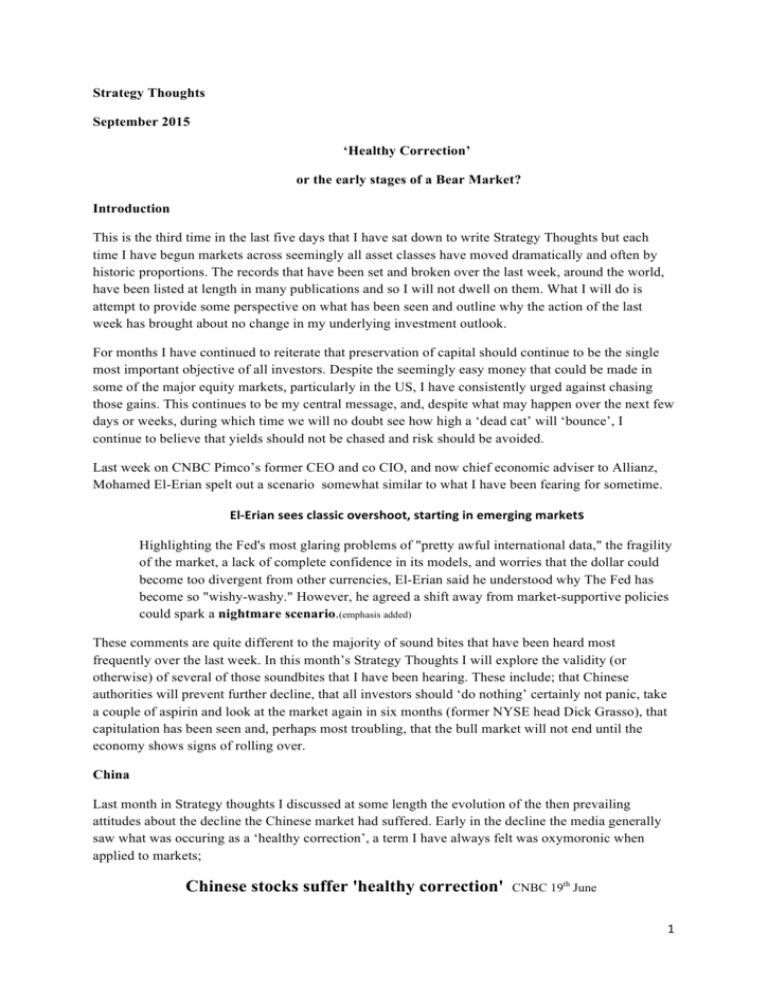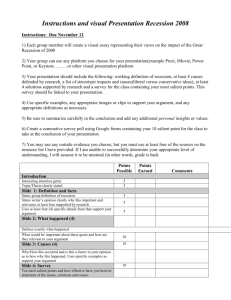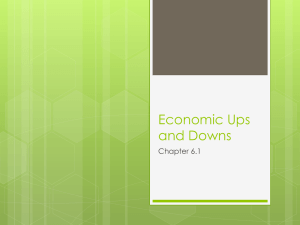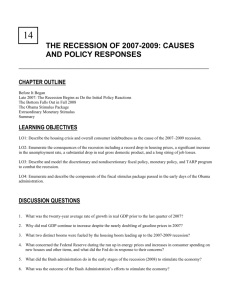Chinese stocks suffer 'healthy correction' CNBC 19th June
advertisement

Strategy Thoughts September 2015 ‘Healthy Correction’ or the early stages of a Bear Market? Introduction This is the third time in the last five days that I have sat down to write Strategy Thoughts but each time I have begun markets across seemingly all asset classes have moved dramatically and often by historic proportions. The records that have been set and broken over the last week, around the world, have been listed at length in many publications and so I will not dwell on them. What I will do is attempt to provide some perspective on what has been seen and outline why the action of the last week has brought about no change in my underlying investment outlook. For months I have continued to reiterate that preservation of capital should continue to be the single most important objective of all investors. Despite the seemingly easy money that could be made in some of the major equity markets, particularly in the US, I have consistently urged against chasing those gains. This continues to be my central message, and, despite what may happen over the next few days or weeks, during which time we will no doubt see how high a ‘dead cat’ will ‘bounce’, I continue to believe that yields should not be chased and risk should be avoided. Last week on CNBC Pimco’s former CEO and co CIO, and now chief economic adviser to Allianz, Mohamed El-Erian spelt out a scenario somewhat similar to what I have been fearing for sometime. El-­‐Erian sees classic overshoot, starting in emerging markets Highlighting the Fed's most glaring problems of "pretty awful international data," the fragility of the market, a lack of complete confidence in its models, and worries that the dollar could become too divergent from other currencies, El-Erian said he understood why The Fed has become so "wishy-washy." However, he agreed a shift away from market-supportive policies could spark a nightmare scenario.(emphasis added) These comments are quite different to the majority of sound bites that have been heard most frequently over the last week. In this month’s Strategy Thoughts I will explore the validity (or otherwise) of several of those soundbites that I have been hearing. These include; that Chinese authorities will prevent further decline, that all investors should ‘do nothing’ certainly not panic, take a couple of aspirin and look at the market again in six months (former NYSE head Dick Grasso), that capitulation has been seen and, perhaps most troubling, that the bull market will not end until the economy shows signs of rolling over. China Last month in Strategy thoughts I discussed at some length the evolution of the then prevailing attitudes about the decline the Chinese market had suffered. Early in the decline the media generally saw what was occuring as a ‘healthy correction’, a term I have always felt was oxymoronic when applied to markets; Chinese stocks suffer 'healthy correction' CNBC 19th June 1 As the fall continued I described how the ‘hope’, or even expectation, grew that the ‘authorities ‘ would somehow reverse this damaging decline; Once the Chinese market began to fall seemingly daily the media was full of reports as to how the authorities were going to prevent further decline. They cut various interest rates, they restricted the issuance of new stock, they made it illegal for large holders to sell their stock, and yet still the market declined! China markets slump despite central bank rate cut The Guardian 29th June People’s Bank of China cuts rates to stem sell-off amid growing fears for health of Chinese economy Despite all the authorities best efforts the broad Chinese market is still down about 25% over the last six weeks. As long as the hope persists that something will reverse this decline it is unlikely that the current bear market has anything like run its course. Over the last four weeks the decline, after a brief rally, has become even more marked; Despite the devastation that has been seen in China over the last week the ‘hope’ that I wrote about last month continues to be very evident. As I write this, mid morning on the 25th August New Zealand time, the media is full of stories about what the PBOC will do to prevent further decline. World looks to China to calm market rout its actions started Miami Herald Monday 24th August, 2015 It would be nice if somehow this ‘magic wand’ could be waved, however, that is not how bear markets end. They end with all ‘hope’ having been expunged amid general expectations that things are destined to only get worse, usually accompanied by learned economists dramatically cutting forward growth expectations Don’t panic and do nothing! The collective memory of investors can prove to be worryingly short and we are seeing evidence of that once again. I have often referred back to a comment that Jeremy Grantham of GMO made in the wake of the GFC when he was asked what people would learn as a result of the financial crisis. He answered; “In the short term a lot, in the medium term a little, in the long term, nothing at all. That would be historical precedent.” 2 Prior to the GFC associated bear market there was a general acceptance of the conventional wisdom that over the long term shares always outperform all other asset classes and buying and holding was the most effective strategy for the majority of investors. However, after eighteen months of massive wealth devastation the validity of these assumptions was under intense scrutiny to the point that some academic studies appeared stating that actually equities don’t outperform bonds over the long term and that buying and holding may not be all an individual investor needs to do. The GFC changed the way many thought about the market, some different lessons had been learned, but then over the next few years, particularly in the US, as markets rose those new lessons were gradually forgotten and the comfort of equities for the long term and buying and holding returned to the fore, to the point that comments such as those I mentioned in the introduction proliferated in the wake of the last few days of devastation. Like the assessments of economists these measured platitudes do provide some comfort amid what undoubtedly are unsettling times. But the idea of not panicking and sitting tight, whether an aspirin has been taken or not, may make sense over the truly long term and for those investors with incredible intestinal fortitude. The problem is that the majority do not possess these qualities and whilst they may withstand some early pain in a bear market eventually the pain grows to such an extent, as the losses mount up with each down day, that eventually they just want out. The real irony is that when a final bottom does appear there will be very few talking heads urging investors to prudently not panic and to hold for the long term or buy more. Those same commentators will be the ones outlining just how bad things are and how much worse they can get. It is these swings in attitudes and sentiment that actually drive markets. Capitulation On August 24th Bloomberg headlined an interview with the head of equities at Hermes Investment Management; Equities Bloodbath ‘Smacks of Capitulation’ Says Parry In the interview Parry talked about the opportunity that the ‘capitulation’ presented. This measured, comforting and appealing sentiment was repeated by experts across the business and mainstream media in the wake of the dramatic and apparently indiscriminate selling that was witnessed. These assessments reminded me a great deal of what was witnessed in early October 2008. At that time markets had been falling for about a year, rather than just a few months, and had already fallen substantially (the Dow was down about 40%). The ‘bloodbath’ then began on the 2nd October with the Dow falling 350 points. Over the next five trading days the Dow fell 150, 370, 510, 190, and 680 points. The consensus among media experts was that a capitulation point had been reached. On the 13th October I wrote; Over the last few weeks the search for a climactic sell off or ‘capitulation’ has become substantially more than a cottage industry with virtually every investor the world over now knowing about capitulation and how it will mark a great long term buying opportunity. Given this, everyone seems to have taken it upon themselves to look for signs of capitulation. Unfortunately markets are never quite that obliging. Capitulation is not something that one group does so as to allow all those looking for it to take advantage, true capitulation is seen by the overwhelming majority as the last chance to get out before things really get bad, not a widely recognised great buying opportunity. 3 As I wrote earlier, the current tendency to view what has been seen over the last weeks as capitulation is eerily reminiscent of October 2008. Back then, after what was seen as the capitulation low the Dow did indeed rally, bouncing about 14% over the next three weeks, but then the bear market resumed. Four months later, by the time the ultimate bottom was finally reached in early March of 2009 the Dow had fallen a further 33% from that rally high and was 23% lower than what had early been seen as the capitulation bottom. Interestingly, in March of 2009 there was substantially less chatter about a capitulation point having been reached. The associated press provided wonderful insight into what the mood was in early March 2009. On the 7th March (two days before the actual low) they published; The ailing economy: How sick can it get? The recession is already in its 15th month, making it longer than all but two downturns since World War II. For now, everything seems to be getting worse: The Dow is in free fall, jobs are vanishing every day, and one in eight American homeowners is in foreclosure or behind on payments. But the economy always recovers. It runs in cycles, and economists are watching an array of statistics, some of them buried deep beneath the headlines, to spot the turning point. The Associated Press examined three markets - housing, jobs and stocks - and asked experts where things stand and how to know when they've hit bottom. None of them expects it to come anytime soon. Of course we now know that two days later one of the best buying opportunities in many decades presented itself. Historic capitulation points, almost by definition, cannot be identified in real time by a majority of media experts. Unfortunately no one should take any comfort from the repeated assertion that a capitulation point has been seen. Is it really the economy that matters? Last month I concluded Strategy Thoughts with the following comment about the comfort of economic forecasts. Taking comfort from economic forecasts when investing is unfortunately fraught with problems. Firstly, the forecasts are highly likely to prove wrong, particularly ahead of important inflection points, and secondly, even if they are right it is likely that the markets were forecasting that outcome long before the forecaster. It really is a case of putting the cart before the horse. Successful investing requires an appreciation of crowd psychology and herding and an acceptance that the most successful long term investment decisions probably feel very lonely and uncomfortable for a long period of time. In mid June CNN ran the following story; Calm down. U.S. stocks are likely to keep going up for now Stock market rallies don't end simply because "it's time." There has to be a trigger, and there isn't an obvious one right now. 4 Most bull markets end because the economy goes into recession, RBC says. Given the current economy, the risk of a recession is low. Watching the media coverage over the weekend, and early this week, I heard a similar refrain over and over again, ‘don’t worry; the current bull market will not end until the economy rolls over’. These comments undoubtedly provide the public with some comfort, unfortunately, as is so often the case in markets, that comfort is totally misplaced. By the time a recession is broadly obvious to the vast majority it is true that a bear market will likely have begun, in fact it is often the case that by such time the bear market is in fact already over. Don’t expect consensus economic views on the economy to provide any sort of early warning sign for the stock market. In the May 2010 edition of Strategy Thoughts, titled ‘“it’s the economy stupid”, or is it?’ I reviewed the value, or otherwise, of knowing when a recession had begun and ended, at the time there still existed considerable doubt as to whether the GFC associated recession had in fact ended, this despite the market having been rising for more than a year; Business Cycle Dating Committee, National Bureau of Economic Research NBER COMMITTEE CONFERS: NO TROUGH ANNOUNCED CAMBRIDGE, April 12 -- The Business Cycle Dating Committee of the National Bureau of Economic Research met at the organization’s headquarters in Cambridge, Massachusetts, on April 8, 2010. The committee reviewed the most recent data for all indicators relevant to the determination of a possible date of the trough in economic activity marking the end of the recession that began in December 2007. The trough date would identify the end of contraction and the beginning of expansion. Although most indicators have turned up, the committee decided that the determination of the trough date on the basis of current data would be premature. Many indicators are quite preliminary at this time and will be revised in coming months. The committee acts only on the basis of actual indicators and does not rely on forecasts in making its determination of the dates of peaks and troughs in economic activity. The committee did review data relating to the date of the peak, previously determined to have occurred in December 2007, marking the onset of the recent recession. The committee reaffirmed that peak date. The NBER have been dating business cycles in this manner since 1978 and an analysis of the four completed recession / expansion cycles to date, using their dates, reveals the following; 1. Two recessions, 1991 and 2001, had actually finished before they were formally announced as having started and the 1980 recession was only one month away from ending when the start was formally announced. 2. Bear markets have on three out of the last four occasions begun well before a recession began. In 1990 the two were coincident. 3. Waiting for a recession to be declared before selling the market has been an expensive exercise. On average the market is 8% lower by the time a recession has been declared 15 months later. (This grows to 16% lower if the not yet officially completed current recession is included!) 4. Waiting for the economic “all clear” to be sounded, by the end of a recession, has been even more expensive. Given the lengthy, 16 month, delay between a recession ending and the end being declared, added to the fact that on three occasions a bull 5 market has begun while a recession is still in progress, the market is 36% higher when the end of the recession is finally declared over. (Again this statistic gets greatly increased if the current recession were included. If the recession were officially ended now the average rise would increase to almost 45%) The US stock market actually peaked in October 2007, and by late November 2007 it had fallen into correction territory (down 10%), as markets did late last week. At the time the attitude of the majority of commentators was not one of panic, far from it in fact. The IMF in their World Economic Update late in 2007 commented quite optimistically about the prospects for global growth, even after cutting their forecast by ½% (it would turn out to be their first of many such cuts); Although growth would remain a solid 4¾ percent, supported by generally sound fundamentals and the strong momentum in the emerging market economies And the IMF was far from alone in their relatively upbeat assessment. Contrary to the conventional wisdom that bull markets somehow end because of an economic calamity, they in fact tend to end amid extremes of optimism and high expectations on the part of investors, economists and analysts. What then tends to occur is that the news coming out, whilst still good by historic standards, it is not quite as good as the majority by then hope for. It is this slight disappointment that causes a market to roll over. As the market begins to fall most of the commentary tends to dwell on the ‘healthiness’ of the correction and that the economy, whilst not as great as had been hoped it is still in good shape. From there, as markets continue to slip the news also continues to slightly disappoint. As a result forecasters, who previously through the bull market were playing leapfrog with the news and the market to keep ahead of it by raising estimates, have to keep shaving there expectations and estimates. As the fall continues eventually commentators realise that the background news is now actually quite bad by historical comparison and begin to slash their forecasts and expectations and it becomes apparent that a recession, or worse, is occurring. By the time this bleak outlook is widely embraced it may well be the case that the actual recession has ended and it is almost certain that the bear market has already bottomed. This can easily be seen in the last two recessions. The great bull market of the nineties ended in March 2000 and fell to a final low in September 2002. The recession associated with this bear market began, according to the NBER, in March 2001, twelve months after the bear market began but this was not finally determined and announced officially until November 26th 2001. Ironically November 2001 was also the month that the NBER eventually determined that the recession ended, but this wasn’t announced until July 17th 2003, six months after the bear market had ended and with the market already having risen 25%. The most recent bear market began in October 2007 and ended in March 2009. The recession (GFC) associated with this decline actually didn’t begin until three months after the market peaked, in December 2007, but this wasn’t officially announced until twelve months later, in December 2008. This was only three months before the bear market ended but the recession was apparently not over until June of 2009, three months after the start of the new bull market and with the market having already risen 40%. Unfortunately for investors waiting for the economic all clear to be sounded before investing, the ending of the recession in June 2009 was not officially declared until September of 2010 by which time the market had already risen 75%. 6 Comforting assessments from economists and others about the positioning of a market may seem measured, considered and sensible, and may provide some comfort, but history has repeatedly shown that, unfortunately, one should take little if any comfort from such commentary. An antidote to the generally still upbeat assessment of the US economy in particular was provided by fund manager John Hussman in his latest weekly comments. He looked back over the last seventy five years at periods where the internal characteristics of the US market had deteriorated, as they have recently, following a period when the market was historically overvalued, overbought and sentiment was overly bullish. The chart shows the cumulative effect of investing through such periods. Where the line moves sideways the current set of conditions have not been in place. What is quite apparent is that there has been very little money made and substantial losses suffered when the current conditions have been in place. Gold Last month in my discussion of the then prevailing consensus outlook for the price of gold I included the following headlines. Deutsche Bank says gold's fair value is $US750 an ounce Gold Looks Like a 'Textbook' Short HSBC cuts 2015, 2016 gold price forecasts Here's why gold is doomed Gold Is Only Going to Get Worse Two reasons why gold may plunge to $350 an ounce I was using these examples to illustrate that attitudes were a near one hundred and eighty degree reversal from where they had been four and five years ago when gold was peaking. At the time, in late July, gold was trading at about $1085 an ounce. Over the next few weeks the price of gold changed, 7 rising at one point by $80 to $1165, but it seems attitudes remained steadfastly bearish. On the 11th August CNBC ran the headline; Gold demand plunges to 6-­‐year low as Asian buyers retreat On the same day they also ran the following story; Gold looks headed for $980 per ounce Reuters, on the 10th August, reported that investment banks have continued the trend of reducing gold price forecasts I highlighted last month; BofA Merrill cuts 2015 gold, silver price forecasts The firm cut their forecast for 2015 to $1050 and to below $1000 for 2016. McGraw Hill Financial two days earlier reported that UBS were engaged in similar price target reductions; UBS cuts one-­‐month gold price forecast 13% on possible US rate hike The analyst at UBS was quoted “Our new price forecasts signal our view that there is scope for further downside in gold from here on the back of both macro and gold fundamental factors over a one-month time frame," Having given an upbeat assessment for the prospects of gold last month I am at the same time pleased and disappointed. I am pleased that my view that attitudes and sentiment had shifted to such a negative extreme seems to have proved right, I am disappointed that I did not get around to making the purchase I had indicated I wanted to make. However, one thing I have learned over the thirty four years I have been following markets is that there will always be another opportunity and there is no need to chase opportunities that have been missed. I will continue to monitor gold closely. US Dollar The chart to the left is the ETF that replicates the price movement of the US dollar index. This is the vehicle I have mentioned in the past and is the one that I am currently still invested in, although I did sell half my position in February, as I discussed at the time in Strategy Thoughts. 8 I continue to look for further upside in the US dollar and am therefore maintaining the position that I have, however, I do not think that the next leg up in the US dollar will be triggered by expectations of Fed interest rate hikes. Rather I think it will be in response to increased turmoil and uncertainty in global markets. In the past when the US volatility index has risen sharply the US dollar has rallied on the back of its being seen as a safe haven. This has not been the case to date, through the last week or so of turmoil, however, I do not think that this bout of turmoil is anywhere near to being over. High Yield ‘Crash’! Don’t chase yield Six months ago, in the March edition of Strategy Thoughts, titled ‘Complacency’, I included the chart below and the following comments; Late last year I commented on the weakness that was being seen in US junk bond markets and used the Barclays High Yield Bond ETF (left) to illustrate that weakness. Throughout the first couple of months of this year, as junk bonds were flying off the shelves in Europe, that weakness has been partially, and quite dramatically, reversed. Another sign that fear is fading and the pursuit of yield is in full force, or put another way, it is yet another sign of complacency on the part of investors! To the left is an update of the chart above. The time scale is similar, however, the vertical axis has been adjusted to accommodate the recent turmoil and decline. My comments about the preceding rally being evidence of complacency may have been correct; however, just because the market has fallen sharply since then it does not mean that a bottom is in place. During the GFC this ETF halved. This in no way means that a similar fall lies ahead but during the deflationary deleveraging process that still lies ahead the risk of defaults in the high yield world increases. For a very long time I have been urging readers not to chase yield. I continue to believe that to be the appropriate strategy. Another Apple update (or the value of what everyone already knows!) I titled the April edition of Strategy Thoughts ‘What everyone already knows doesn’t help! The Wonder of Apple?’ The point I was attempting to make in that edition was that by the time everyone 9 knows something, even if it is correct, it is of absolutely zero value from an investment perspective because by definition it has to already be reflected in market prices. I extended that observation by highlighting that by the time a stock is considered eligible and worthy for inclusion in the Dow Jones Industrial Average the entire world is probably more than familiar with the virtues of that company. Similarly any stock that is removed has likely been a poor performer for an extended period, again evidence that the majority are probably more than familiar with its shortcomings. On March 18th the largest company in the world by market capitalisation, Apple, replaced a tired old ‘Ma Bell’, AT&T. Over the last four months this switch has followed pretty much the pattern that has been seen throughout history, the new comer has struggled and the dumped stock has recovered. Since Apple replaced AT&T in the Dow Jones industrial Average, Apple has fallen 20% in value, AT&T is down just 4% and the Dow itself has fallen 20%. Naturally I will continue to monitor this but hopefully it is already clear that the comfort of the crowd, and not standing out, may be alluring but it is not the position from which investment success is found. Conclusion Writing this month’s Strategy Thoughts has presented me with a most unusual challenge. Whilst my capital preservation strategy has proven of value over the last month, and in some markets over a far longer period, I have found it difficult to sit down and write as markets have presented an almost impossible moving target. I have done my best to outline what I believe to be happening, and it is not a benign ‘healthy correction’. I have long stated that I consider 2000 to have been the end of the secular bull market for most developed world equity markets and that what has been seen since has been a series of cyclical bull and bear markets within a much larger secular bear market. That secular bear market will eventually end with equities at historically incredibly cheap valuations, that is when the greatest opportunity since 1982 will be presented. In the meantime it is important that capital is preserved. I believe the next, and probably final, cyclical bear market within this larger secular bear market has now begun in the US (in other markets it began several years ago). Its progression will not be smooth and there will likely be many rallies along the way. Each rally, as the market slides down the ‘slope of hope’ will probably be seen as a resumption of the prior bull market until finally all hope is extinguished and expectations become quite bleak. That is when real investment opportunities will be found. In the meantime; ignore commentary expounding on the health of any economy and why that is good for markets, avoid risk and passive buying and holding, disregard commentary about capitulation points having been seen and do not chase yield. Kevin Armstrong 25th August 2015 Disclaimer The information presented in Kevin Armstrong’s Strategy Thoughts is provided for informational purposes only and is not to be considered as an offer or a solicitation to buy or sell particular securities. Information should not be interpreted as investment or personal investment advice or as an endorsement of individual securities. Always consult a financial adviser before making any investment decisions. The research herein does not have regard to specific investment objectives, financial situation and the particular needs of any specific individual who may read Kevin Armstrong’s Strategy Thoughts. The information is believed to be-but not guaranteed-to be accurate. Past performance is never a guarantee of future performance. Kevin Armstrong’s Strategy Thoughts nor its author accepts no responsibility for any losses or damages resulting from decisions made from or because of information within this publication. Investing and trading securities is always risky so you should do your own research before buying or selling securities. 10







